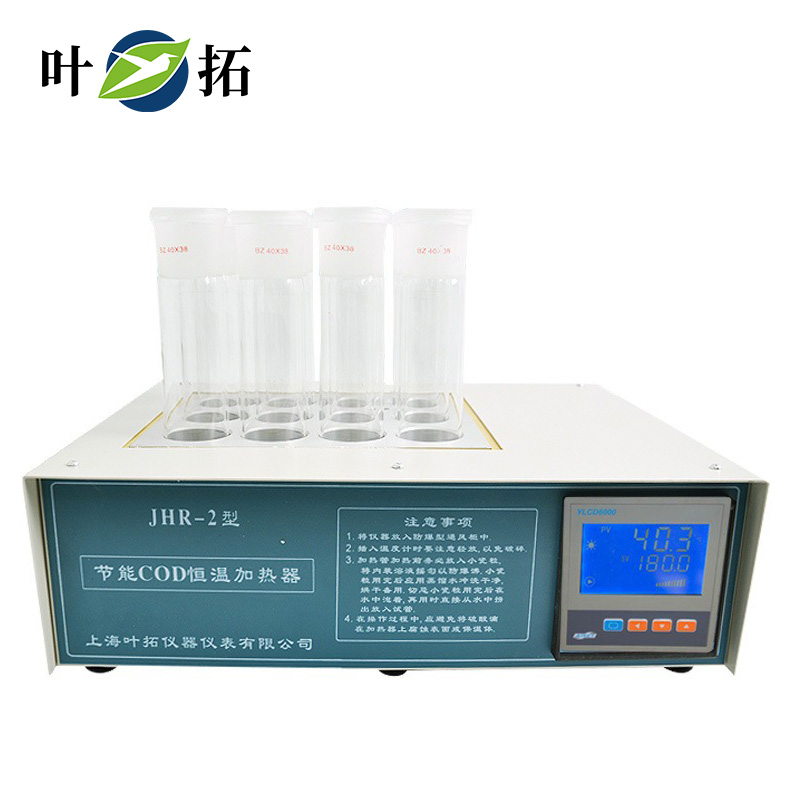

Product parameters:
model: JHR-2
Measurement time: ≤ 150 minutes
Working power supply: AC220V ± 10%/50HZ
Temperature control accuracy: ± 1 ℃
Product size: 355 * 320 * 110MM
Heating time:<30 minutes
Batch processing samples: 12 samples
Temperature control range: Room temperature -200 ℃
Average power consumption: ≤ 880 watts
Temperature control error: ± 0.2 ℃
Environmental temperature: 5-40 ℃
Weight of goods: 22kg
Cargo volume: 0.12m ³
Host: 400 * 300 * 120mm
Heating zone size: 220 * 180mm
Aperture: diameter 450mm * 65mm high
Measurement range: 5-1000mg/L, 1000-10000mg/L (dilution)
- Product Details
- Product manual
Yetuo JHR-2 COD Constant Temperature Heater
model: JHR-2
Product Overview:
This device consists of an energy-saving COD constant temperature heater, heating tubes, and air condensation tubes. The energy-saving COD constant temperature heater adopts a cast aluminum furnace body with good thermal conductivity. The furnace body is evenly distributed with 12 constant temperature heating tanks, which can make 12 samples at the same time. The furnace temperature is transmitted from the temperature sensor to the control circuit, and the automatic constant temperature heating tube and condensing tube are made of hard glass with a small coefficient of thermal expansion. When in use, add the water sample and reagent to be digested into the heating tube, install an air condenser tube, and place it in a constant temperature bath. Ensure good boiling and sufficient reflux of the mixer inside the tube at operating temperature (165 ℃~180 ℃).
Debugging of Yetuo JHR-2 COD Constant Temperature Heater Product:
Check if the heating tube is broken.
Insert the randomly attached thermometer into the temperature measuring hole.
Plug in the power plug and turn on the power switch. At this time, the instrument screen displays the current measured temperature, and the heating indicator light is on to indicate that the instrument is heating. Press the setting button, and the screen flashes to display the current displayed constant temperature. Use the button to modify the constant temperature. After modification, press the setting button again to save the new set value. During the setting process, the constant temperature will not change. If a button is pressed within 30 seconds while in the setting state, the instrument will automatically exit the setting state and maintain the set constant temperature unchanged.
Note: Due to good insulation, if the temperature is higher than the set temperature, the temperature drops slowly. After modifying the set temperature, it may take a longer time to reach the new set constant temperature and maintain stability.
usage method:
Connect the power supply, turn on the power switch, insert the thermometer into the hole for preheating for 30 seconds, and adjust the temperature to around 170-180.
When the chloride ion content in the wastewater exceeds 30ng/L, 0.4g of mercuric sulfate should be added to the heating tube first. A water sample of 0.00m mixed evenly (or an appropriate amount of water sample diluted to 20.00ml) should be taken into the heating tube, and 10.00ml of potassium dichromate standard solution and 30ml of silver sulfate solution should be accurately added. Dozens of dry ceramic particles should be added. Gently shake the heating tube to mix the solution evenly.
Connect the condenser tube to the heating tube, place it in a constant temperature heating hole, and heat it for 2 hours from boiling. After boiling for 2 hours, remove the heating tube and condenser tube from the heating hole, place them on the heating tube bracket, and cool them naturally or with flowing water.
Rinse the condenser tube wall and grinding area with a small amount of water, carefully remove the condenser tube, dilute it with water to about 140ml, add 2-3 drops of ferrous indicator, add clean probe and stir, and titrate with ferrous ammonium sulfate standard solution under electromagnetic stirring until the solution color changes from yellow to blue to reddish brown, which is the endpoint. If there is no electromagnetic stirrer, the solution in the heating tube can be quantitatively transferred to a 500ml conical flask, diluted with water to about 140ml, and titrated to the endpoint.
At the same time as measuring the water sample, perform a blank test with 20ml distilled water according to the same operating steps, and record the amount of ferrous ammonium sulfate standard solution used for titrating the blank.
matters needing attention:
When using the instrument, it should be placed in a fume hood and the cabinet door should be closed to prevent the generation of irritating gases or acid splashes during heating, which can cause harm to the human body.
Before heating the heating tube, it is necessary to add small ceramic particles (glass beads should not be used instead of small ceramic particles) and shake the solution evenly to prevent boiling.
If the concentration of chloride ions in the water sample is greater than 300mg/L, the standard method can be used to strengthen sulfuric acid removal
Chloride ion interference.
During operation, sulfuric acid should be avoided from dripping onto the heater to corrode the surface or insulation. Attention should be paid when inserting a thermometer to avoid breakage. After reaching the working temperature, the thermometer can be removed.
When the heater is not in use, please unplug the power plug.
During maintenance, first unplug the power plug and then open the top cover for inspection. Never open the top cover without unplugging the power plug to avoid electric shock.
After using up the small ceramic particles, rinse them clean with deionized or distilled water. Dry for later use. Remember to soak the small porcelain particles in water after use, and then directly remove them from the water and put them into a test tube when using them again.

 Alibaba Store
Alibaba Store Tmall Store
Tmall Store Jingdong Sstore
Jingdong Sstore






